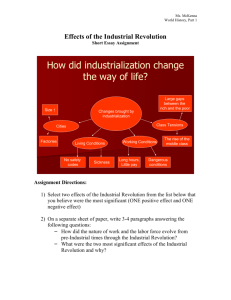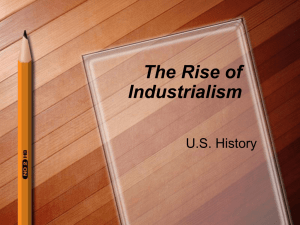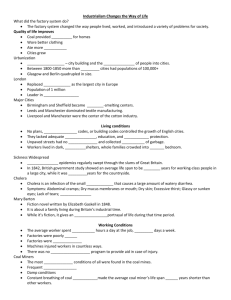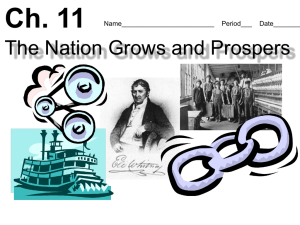Chapter 11, Section 2 Outline: Industrial Location Factors
advertisement
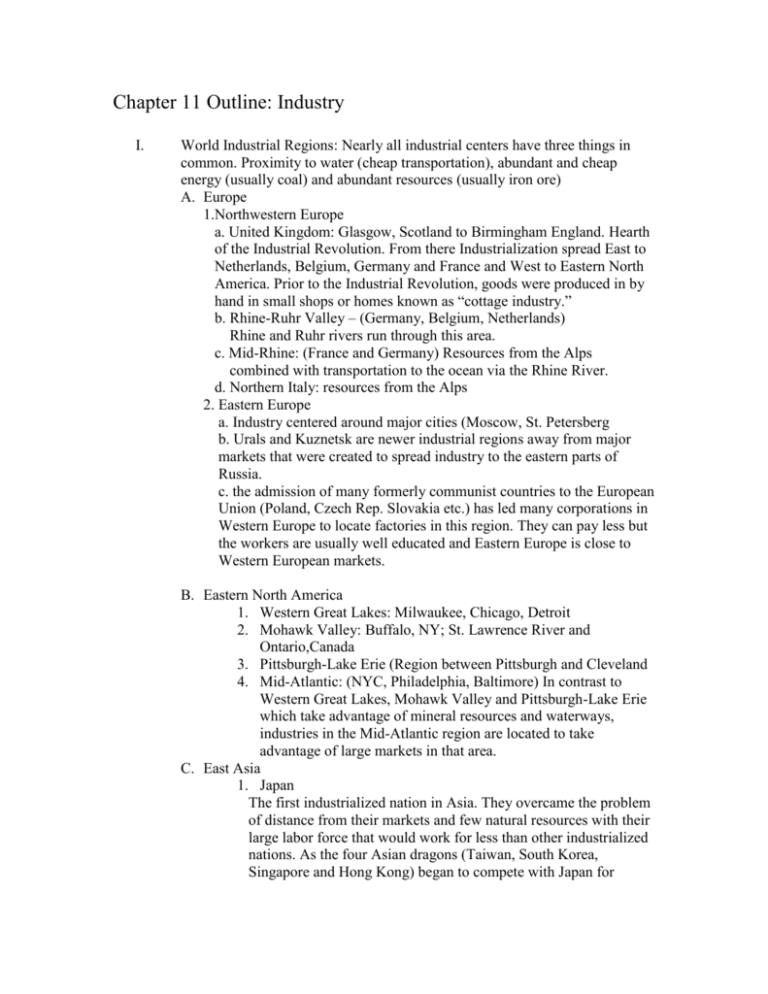
Chapter 11 Outline: Industry I. World Industrial Regions: Nearly all industrial centers have three things in common. Proximity to water (cheap transportation), abundant and cheap energy (usually coal) and abundant resources (usually iron ore) A. Europe 1.Northwestern Europe a. United Kingdom: Glasgow, Scotland to Birmingham England. Hearth of the Industrial Revolution. From there Industrialization spread East to Netherlands, Belgium, Germany and France and West to Eastern North America. Prior to the Industrial Revolution, goods were produced in by hand in small shops or homes known as “cottage industry.” b. Rhine-Ruhr Valley – (Germany, Belgium, Netherlands) Rhine and Ruhr rivers run through this area. c. Mid-Rhine: (France and Germany) Resources from the Alps combined with transportation to the ocean via the Rhine River. d. Northern Italy: resources from the Alps 2. Eastern Europe a. Industry centered around major cities (Moscow, St. Petersberg b. Urals and Kuznetsk are newer industrial regions away from major markets that were created to spread industry to the eastern parts of Russia. c. the admission of many formerly communist countries to the European Union (Poland, Czech Rep. Slovakia etc.) has led many corporations in Western Europe to locate factories in this region. They can pay less but the workers are usually well educated and Eastern Europe is close to Western European markets. B. Eastern North America 1. Western Great Lakes: Milwaukee, Chicago, Detroit 2. Mohawk Valley: Buffalo, NY; St. Lawrence River and Ontario,Canada 3. Pittsburgh-Lake Erie (Region between Pittsburgh and Cleveland 4. Mid-Atlantic: (NYC, Philadelphia, Baltimore) In contrast to Western Great Lakes, Mohawk Valley and Pittsburgh-Lake Erie which take advantage of mineral resources and waterways, industries in the Mid-Atlantic region are located to take advantage of large markets in that area. C. East Asia 1. Japan The first industrialized nation in Asia. They overcame the problem of distance from their markets and few natural resources with their large labor force that would work for less than other industrialized nations. As the four Asian dragons (Taiwan, South Korea, Singapore and Hong Kong) began to compete with Japan for manufacturing jobs, they trained their workforce to produce more complex products like electronics and cars. 2. China Now the world’s second largest manufacturer. Although China claims to be Communist (which is a self-sufficiency approach to development), it justifies international trade through designating regions such as Shanghai, Tianjin and Shenyang as “special economic zones.” D. Latin America 1. Mexico Increasingly important source for U.S. manufacturing. The North America Free Trade Agreement eliminated tariffs between Mexico, U.S. and Canada thus creating another “special economic zone” along the border between Mexico and the U.S. Factories that produce goods for American consumers are called “maquiladora.” 2. Brazil Also increasing industrial production for markets in South, Central and North America. Labor is more expensive in Brazil ($400/month) than in Asia ($100/mo) but transportation costs are lower from Brazil to the U.S. than from Asia to the U.S. a. the practice of putting a dollar amount on the worth of a worker is called “commodification.” It is condemned by human rights activists because they believe that no amount of money can truly represent the worth of a human being. II. Location Factors: Situation proximity to inputs vs. markets Considers which costs more-transporting raw materials to factory or finished products to consumers A. Proximity to Inputs (raw materials/natural resources) 1. copper industry- the amount is greater upon arrival to the factory than when it leaves. a. only 25% of the material brought in from mines actually becomes copper wire, sheets etc. 2. steel industry- mine iron- which is refined by smelting (adding carbon, heat and water) 3. U.S. Steel Industry- Industrial Era (mid 1800’s to mid 1900’s) a. located near water (the cheapest type of transportation) Great Lakes, Mississippi River, Ohio River, St. Lawrence River, Erie Canal b. located near large deposits of coal and iron ore. c. Cities such as Milwaukee, Chicago, Detroit, Cleveland, Buffalo and Pittsburgh grew as a result of steel industry and other industries that grew out of steel production (agglomeration) 4. Changing U.S. Steel Industry a. changing economy-(globalization, outsourcing, new international division of labor) have impacted the U.S. steel industry b. surviving factories are actually closer to markets than inputs. c. Steel production has adapted reduce costs. They are more specialized. Now 25% of steel production is done in minimills that produce only one type of steel product (beams, sheet metal etc.) verses integrated mills that are involved in all aspects of steel production. B. Proximity to Markets (Market Orientation) 1. Bulk gaining industries- products are composed of many small parts that make them bigger/heavier when they leave the factory than when they came in. a. soft drinks- mostly made of water (which is heavy and abundant) so plants are located near major population centers so that the only thing shipped to the plant is the syrup. b. Fabricated Metals and Machinery- bring in a variety of parts that are made in other factories and assembled. c. automobiles: production began in Detroit, but while company headquarters are still there, production facilities were moved near the largest markets on the east and west coast. d. 1950 U.S. manufacturers produced 100 different models of cars. In 2000, there were 700 models produced in the U.S. Most models are made in factories that exist just for one model of car. e. To cut costs and become more efficient, factories located away from the east and west coasts and are located in the center of the U.S. between Michigan and Mississippi. This region is known as “auto alley.” 2. perishable products-products that are only good for a limited time. a. Food or drink that will spoil is located near the market where it will be sold. b. Canned, frozen or preserved foods can be located further from markets c. Newspapers and magazines: used to be only local due to transportation and information constraints. Advances in technology allow major newspapers to be written in one place (New York Times, Wallstreet Journal, USA Today) but printed and distributed near major markets. 3. Weber’s Lest Cost Theory The larger and heavier the product is, the more likely it is to be manufactured near the market where it is sold. 4. Footloose Industries (computer software and electronics) Industries that are not tied to a certain location a. size is small enough to minimize transportation costs b. resources are abundant and found in many locations c. is not labor intensive (labor is not the biggest cost in production). C. Modes of Transportation: Ship, Rail, Truck or Air? The further from the market the cheaper the cost per mile. All goods have loading and unloading costs. 1. Ship-is the slowest but least expensive form of transportation 2. Rail-used for products shipped long distances inland. 3. truck-used for products transported relatively short distance or to places that aren’t served by rail. 4. air- most expensive but also the fastest. Some companies use air because of the time-sensitive nature of their product. 5. Break-of-Bulk Points- places where products are exchanged from one mode of transportation to another. a. “just-in-time” delivery: advances in transportation and communication allows parts and products to be shipped so that they arrive “just in time” to be used. This cuts the cost of renting space for storage. III. Location Factors: Site Costs involved in making a product that doesn’t involve transportation. A. Labor 1. labor intensive industry-the majority of the cost of production is in the labor needed to produce it. a. labor intensive does not equal high wages; labor intensive=low wages b. labor intensive industries are usually outsourced to LDC’s where labor is five or six times cheaper c. textiles: account for 6 percent of all industry, whereas labor from textiles accounts for 14 percent of all wages 2. “Right to Work Laws” many states in the South and West have “open shop” laws that allow people to work without joining a union. Many states in the northeast have lost factory jobs because they have “closed shop” laws that require workers to join a union in order to work in certain industries. B. Land-there are many factors that influence the decision of which parcel of land upon which to build a factory. 1. climate 2. proximity to sources of energy a. aluminum plants use a lot of energy, so they locate near sources of cheap energy like hydroelectric power or wind power. 3. proximity to cheaper land and labor- while some U.S. manufacturing has moved to other countries, some factories have moved South and West to take advantage of cheaper labor. C. Capital 1. availability of money to invest in the growth of the company a. auto industry could have started in many cities of the Midwest. The willingness of banks to lend money in the Detroit area is a major reason why the headquarters ended up there. b. Silicon Valley, Ca: growth of the computer industry started because of the availability of capital to start computerrelated companies. IV. Where is Industry Expanding? (Key Issue 3) A. Intra-regional shifts in manufacturing (shift from urban to rural/semi-rural) 1. Early factories located near cities for proximity to labor and markets. Built multi-story buildings to save on land costs. 2. modern factories are locating in suburbs or rural locations due to cheaper land and advances in transportation and communication. It is more efficient to have factories on one level. 3. Shipping costs are also lower in semi-rural locations because raw materials don’t have to be transported as far. B. Inter-regional shifts in manufacturing 1. factories relocated from the northeast to the southeast and west. a. cheaper land b. cheaper labor (right to work laws) c. warmer climate 2. shifts in Western Europe from northeast to southeast a. U.K. and Germany (Rhine)have water transportation, iron ore and coal just like the Midwestern U.S. b. European governments have encouraged/required relocation of factories to less developed parts of Europe. c. As countries turned from Communism to Capitalism, factories began to move to the east because of the highly educated workers who would work for less money.



